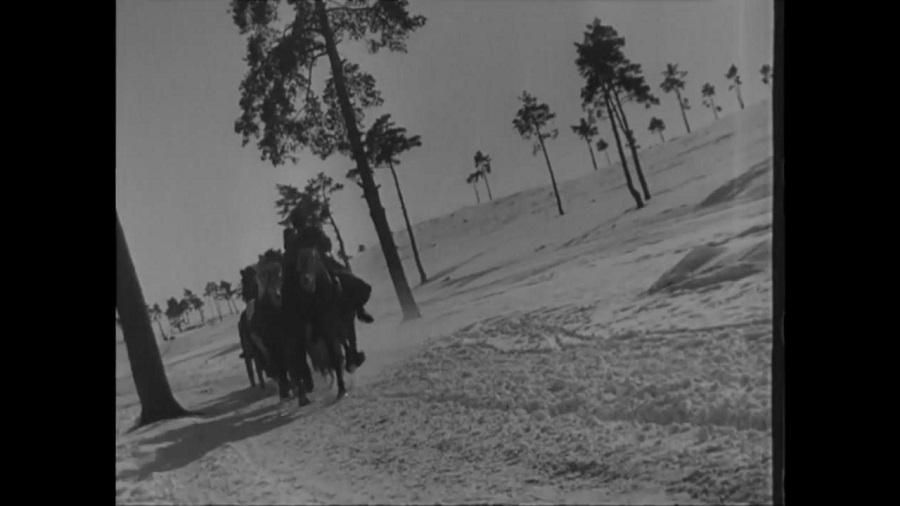Ukraine, Year Zero
Arsenal is not a film that will brighten up your quarantine, but I think it might be one of my most powerful viewing experiences during the pandemic. Aleksandr Dovzhenko’s second feature film was made on commission, on the Bolshevik revolution’s tenth anniversary – but its execution vastly surpasses the narrow constraints of agitprop. Here Dovzhenko manages to bring together, in a splendid cinematographic gesture, war and famine, revolution and death, the sinister poverty of the countryside and the exhilarating boost of change. A film which summarizes complicated times, Arsenal shrouds the New Soviet man’s joy in a thick shroud of sadness.
Having been overshadowed by Serghei Eisenstein for a long period of time, Dovzhenko was enthusiastically rediscovered, especially by critics from the United States. Film critic Jonathan Rosenbaum repeatedly wrote about his films, while academic Gilberto Perez dedicates him an entire chapter in his wonderful work, The Material Ghost. A versatile, yet unlucky filmmaker, whose relationship with the Stalinist power was strained for long stretches of time, Dovzhenko is probably the most poetic voice of the Soviet School of Montage – which explains the resurgence of his nuanced and subtle films, in which the shriek of life can’t be reduced to ideology or propaganda. The Ukrainian’s career, a great landscape artist, is filled to the brim with striking moments in which the unhinged effort to construct a new society is put on hold, and the camera turns into a window that leads to an undisturbed world. To paraphrase Godard, what stays with you after a film by Dovzhenko? I’d say that we’d rather recall, for example, his fields that ripple in the breeze, the plains onto which sunlight dances, with a luminous grove rumored to hide treasures, or the picture of a young man transfixed by a frenzied dance, raising the dust on a village alleyway, excited at the thought of how his work is useful to the motherland.
The same goes in the case of Arsenal, a film that guides us, though a movement of a camera, from the terrible silence of a God-forgotten village to the revolutionary enthusiasm that grips an entire nation. Regarding the filmography of better-known Eisenstein, I’d say that Arsenal simultaneously encompasses both October and The General Line. In the first part, we see images of an accursed village, where babushkas throw seeds from their laps onto an arid field, and a crippled man, supported by his crutches, crosses an empty alley. Just like in The General Line, a spiritless mare that is whipped by her owner completes the image of ruin. An intertitle informs us that the lands of Ukraine are filled with soldiers – and it doesn’t take a long time for the film to show us that war is completely glamourless, in just a few shots: it is simply sinister and nothing more. In a haunting scene, a toothless soldier inhales laughing gas, and Dovzhenko’s edit juxtaposes him with the image of a fallen military man, a smile frozen upon his face, in a memorable image of the death that is insinuated on all fronts.

Arsenal is atrocious especially in these pretty sluggish moments when the haunting emptiness of the shots is reanimated only by the terror of war. A country brought to its knees, the muted Ukraine featured in this film anticipates the scorched earth of Elem Klimov’s Come and See, but Dozhenko is less prodigal when it comes to extras and war-themed sets. Throughout its course, the film catches speed once the revolution starts to galvanize the people, culminating with the wild race of a wagon throughout the frozen steppe, in order to transport a dead revolutionary to his natal village. Here, the film touches an ecstatic climax that is worthy of the fiery scenes in October, imagining a world where even the horses are capable of speaking through intertitles – „we’re running on all our 24 legs” – as they also participate in the collective revolutionary effort and in the process of paying tribute to the fallen heroes. When they finally arrive in the village, followed by the armed forces, the Bolsheviks lay the dead man at the feet of a woman, quickly telling her „Mother, we have no time for explanations, we are dying and living for the Revolution!”, and then scuttering off.
It’s however remarkable that even in these high-octane moments of glory, in which the earthquake of history happens under our very eyes, Arsenal never fully gives up on its elegiac tone. Death is just around the corner at every step of the story. „Of all the pictures of the revolution projected on the Soviet screen”, says Gilberto Perez, „Dovzhenko’s Arsenal (1929) alone pictures a tragedy. It is a hopeful tragedy, one that looks forward to a better future, but a tragedy nonetheless in its sense of the dolorous cost and waste and its reverberant sorrow.”
Like many other films of its generation, Arsenal discovers real political solidarity in the midst of the workers, which is almost capable of even changing the weather – it’s sunny and torrid one moment, and the next it’s snowed-in, in an upturn of meteorological reasons. But the film astonishes especially through the attention that it grants to small details that usually pass unnoticed in the ebullition of the crowd: when the revolutionaries tie the dead man’s body to the wagon, the heavy rope latches onto his jaw and displaces it. And, in the final scene when, surrounded by enemies, the informal leader of the revolutionary movement desperately throws whatever he has on hand towards his nemeses, his coat covers his face for a fraction of a moment – his last stand thus granted a mythical proportion.
Arsenal is available on MUBI.
Title
Arsenal
Director/ Screenwriter
Aleksandr Dovjenko
Country
URSS
Year
1929
Film critic and journalist; writes regularly for Dilema Veche and Scena9. Doing a MA film theory programme in Paris.


